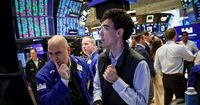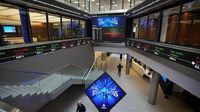Wall Street’s relentless rally showed no signs of slowing this week, as the world’s largest stock markets notched record highs on the back of a dramatic surge in technology shares—most notably Intel and Nvidia—following a pivotal interest rate cut from the U.S. Federal Reserve. The ripple effects of this rally were felt across global markets, with Asian and European indexes reacting in real time to the latest developments in New York.
On Thursday, September 18, 2025, the Federal Reserve announced a quarter-point reduction in its key interest rate, marking its first such move of the year. According to Reuters, this policy shift was designed to support a labor market that has shown signs of softening, even as inflation remains stubbornly high. Fed Chair Jerome Powell emphasized the central bank’s delicate balancing act, noting, “We are looking for support for economic growth and justification of stretched valuations and the prospect of lower interest rates helps that.” Investors, ever attuned to the Fed’s signals, interpreted the move as a green light for further gains, especially in interest-sensitive sectors like technology.
The market’s response was immediate and electric. The S&P 500 gained 0.48% to close at 6,631.96, the Nasdaq Composite jumped 0.94% to 22,470.73, and the Dow Jones Industrial Average rose 124.10 points, or 0.27%, to 46,142.42—all setting new all-time highs, as detailed by Reuters and Bloomberg Quint. The small-cap Russell 2000 index, often seen as a bellwether for risk appetite, soared 2.5% to a record close of 2,467.70, its first since November 2021.
But the real fireworks came from the technology sector. Intel’s stock skyrocketed 22.8%—its best single-day performance since 1987—after Nvidia announced it would invest $5 billion in the chipmaker. According to Devdiscourse and MarketWatch, this investment is part of a broader collaboration between the two companies to develop custom chips for data centers and personal computers. Nvidia, already Wall Street’s most valuable company, saw its own shares rise 3.5%, helping to lift the entire semiconductor index by 3.6% and the S&P 500 technology sector by 1.36%.
The reaction on Wall Street was mixed. Some analysts cautioned that Intel’s rally might have been “too extreme,” while others pointed to potential manufacturing wins ahead. As MarketWatch observed, “What do you do with Intel Corp.’s stock after its best day in 38 years? That’s the big question dividing Wall Street.” The debate underscores the uncertainty that can follow such a dramatic move, even as optimism about artificial intelligence and data center demand continues to buoy sentiment.
The rally wasn’t limited to the biggest names. The broader technology sector surged, with AI-linked stocks particularly in favor. Advanced Micro Devices, a peer to Intel and Nvidia, dipped slightly by 0.8%, but the overall mood was exuberant. Seven of the 11 S&P 500 sectors posted gains, led by Consumer Discretionary, Information Technology, and Communication, while Energy and Financials lagged behind, as reported by Bloomberg Quint.
Economic data provided further encouragement. New unemployment benefit applications dropped, signaling that the pace of layoffs may be slowing, despite the labor market’s recent softness. This was a relief to investors after a previous uptick in jobless claims had stoked concerns about a more pronounced slowdown. The Federal Reserve’s rate cut—widely interpreted as a preemptive move to support employment—has fueled expectations for further monetary easing, with investors pricing in additional cuts by year’s end.
The euphoria on Wall Street spilled over into global markets, but not uniformly. In Asia, shares mostly retreated on Friday, September 19, 2025, as investors digested the Wall Street rally and awaited further policy signals. Japan’s Nikkei 225, after initially rising, reversed course and closed down 0.57% to 45,045.81 following the Bank of Japan’s decision to keep its benchmark short-term interest rate unchanged at 0.5%. Data released the same day showed Japan’s annual inflation in August had slowed to a 10-month low of 2.7%, easing from 3.1% the previous month, according to the Associated Press and Reuters.
Elsewhere in Asia, the mood was similarly cautious. Hong Kong’s Hang Seng index edged up 0.26% to 26,476.86, while China’s Shanghai Composite slipped 0.30% to 3,820.09. Australia’s S&P/ASX 200 managed a 0.32% gain to 8,773.50, rebounding from earlier losses tied to a softer jobs market. South Korea’s Kospi fell 0.46%, India’s BSE Sensex declined 0.53%, and Taiwan’s Taiex dipped 0.74%. Investors across the region were also awaiting the outcome of a phone call between U.S. President Donald Trump and China’s President Xi Jinping, where tariffs and a possible deal to allow TikTok to continue operating in the U.S. were on the agenda.
European markets, meanwhile, opened higher on Friday, buoyed by the Wall Street rally and a series of major monetary policy decisions. The Bank of England held rates steady on Thursday, mirroring the Bank of Japan’s move, while the Federal Reserve’s cut earlier in the week set the tone for risk assets. France’s CAC 40 was up 0.38% at 7,884.10, Germany’s DAX rose 0.04% to 23,682.84, and the UK’s FTSE 100 ticked up 0.01% to 9,229.03 shortly after the open. Spain’s IBEX 35 and Italy’s FTSE MIB also posted gains, according to Euronews and Reuters. The STOXX 600 and STOXX 50 indexes, which track a broad swath of European stocks, were little changed, reflecting a cautious optimism across the continent.
Back in the U.S., the rally’s momentum continued into Friday’s early trading. The S&P 500 opened 0.23% higher at 6,647.39, the Nasdaq gained 0.34% to 22,546.05, and the Dow Jones rose 0.23% to 46,249. Intel, which had soared as much as 25% on Thursday, erased some of its gains and traded nearly 3% lower at $29.67, as investors took profits and reassessed the company’s prospects. Tesla and Oracle were among the day’s top performers, rising 2.14% and 2.59% respectively, while Apple and Microsoft also edged higher.
Commodities and currencies saw mixed moves. Spot gold rose 0.433% to $3,660 an ounce, while Brent crude oil fell 0.56% to $67.05 a barrel. The Bloomberg Dollar Spot Index climbed 0.2%, the euro and British pound slipped, and the yen was little changed at 147.97 per dollar. Bitcoin, the world’s largest cryptocurrency, fell 1.1% to $116,274.11.
As the dust settles from this week’s whirlwind of news, one thing is clear: Wall Street’s tech-fueled rally has injected fresh energy into global markets, but questions remain about the sustainability of such lofty valuations. For now, investors are betting that lower interest rates and the promise of technological innovation will keep the bull market charging ahead.






